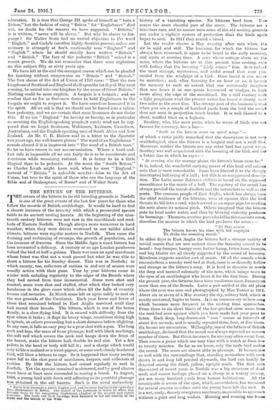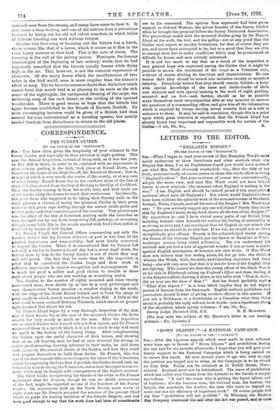THE RETURN OF THI., BITTERNS.
THE return of the bittern to its old breeding-grounds in Norfolk is one of the groat events of the last few years for those who follow the records of British ornithology. It would be hard to find a clearer instance of the tenacity with which a persecuted species holds to its ancient nesting haunts. At the beginning of the nine- teenth century bitterns wore not rare in the marshlands and reed- beds of Eastern Norfolk. Though always more numerous in hard weather, when they wore driven westward to our milder island climate, bitterns were regular nesters in Norfolk. Then came the draining and reclaiming of swamps, the growth of population, and the increase of firearms. Since the Middle Ages a roast bittern has been accounted a delicacy. A century or so ago London poulterers valued the bird at half-a-guinea. There was once an aged raarshman whose boast was that not a week passed but what he was able to shoot a bittern for his Sunday dinner. This was in Norfolk; in which county, too, collectors of rarities in and out of season were usually active with their guns. Year by year bitterns came in winter with unfailing regularity to the edges of the Broads where they had nested from time immemorial. Some were shot and roasted, some were shot and stuffed, after which they looked very handsome in the glass cases which often fill the halls of country houses and rectories. In March some left us again safely to nest on the wet grounds of the Continent. Each year fewer and fewer of those that remained behind in East Anglia survived until they had reared their broods. The bittern, which is one of the heron family, is a slow-flying bird. It is roused with difficulty from the spot where it lurks ; it flaps its heavy wings, sometimes rising high In spirals, at others proceeding but a short distance before alighting. In any case, it falls an easy prey to a poor shot with a gun. The long neck and legs, the mass of lease plumage, buff with black markings, the soft ruff which covers the neck and hangs down the front of the breast, make the bittern look double its real size. Yet a few pellets in the head or body will kill it ; and a charge which would only tickle a mallard or a wood-pigeon, or some such closely feathered bird, will blow a bittern to rags. So it happened that many nesting palm fell to the shot-guns of marshmen, keepers, and collectors of rarities. By 1868 the bittern had ceased regularly to nest in Norfolk. Yet the species remaincd undeterred, and by good chance must have at least once succeeded in rearing a brood. In August, 1886, a young bird with down still adhering to its youthful plumage was obtained in the old haunts. Such is the usual melancholy • Barns Is in language a purely English poet, and far more Anglian in his ewabulary than Shakespeare or Milton. She dialect of the Lowlands In which he wrote was brought there by the conquering Englishmen (Angles) of ths seventh and eighth centuries. The Scots and their language were banished to the hill country of the North and the islands of the West.
history of a vanishing species. No bitterns bred bore. Now comes the more 'cheerful part of the story. The bitterns are a tenacious race, and no sooner were some of the old nesting- grounds put under a vigilant system of protection than the birds again began to nest. In 1911 they reared a brood.
Lot the reader choose a May evening after rain when the air is mild and still. The booming, for which the bittern has always been renowned, is again to be hoard in the early morning, and again at evening time. A man whose cottage abuts on the more, where the bitterns are at this present time nesting, says with feeling that the booming "fairly crazes" him. It is indeed the most strange, mysterious, and awful sound that ever pro- ceeded from the windpipe of a bird. Once heard it can never be mistaken ; and, after listening for an hour or so, it haunts the memory to such an extent that one continually imagines that one hears it as one punts homeward or trudges in high boots along the edge of the marshland. On a still evening with a light propitious wind the present writer has heard it clearly over two miles as the crow flies. The strange part of the business is that when you are a couple of hundred yards from the bird the sound does not seem in proportion much louder. It is well likened to a short, muffled blast on a foghorn.
Southey, who, like most poets, when ho wrote of birds was not famous for accuracy, has a line- " Swift as the bittern soars on spiral wings "-
of which a critic justly remarked that the description is not very ornithological, since the bittern is a languid and not a swift flier. Moreover, neither the bittern nor any other bird has spiral wings. Southey was well acquainted with the booming of the bird, and has a better line in which he says :— "At evening, o'er the swampy plains, the bittern's boom came far." It is, indeed, the wonderful carrying-power of this loud and solorna note that is most remarkable. Some have likened it to the sharply interrupted bellowing of a bull ; but this is an exaggerated descrip- tion. The Latin name Botaurus stellaris is based on the supposed resemblance to the music of a bull. Tho mystery of the sound has always puzzled the marsh-dwellers and the naturalists as well as the poets. The common people of East Anglia, which has always been the chief residence of the bitterns, were of opinion that the bird thrusts its bill into a reed, which served as an organ-pipe for swelling the note above its natural pitch. Others imagined that the bittern puts its head under water, and then by blowing violently produces its boomings. Thomson, another poet who fell in this case into error, describes the manner in which the bird produces the noise :—
" So that scarce The bittern knows his time with bill ea,gulpht To shako the sounding marsh."
In olden days in East Anglia the bittern had a strange variety of trivial names that are now extinct since the booming ceased to be heard : bog-bumper, bumpy coss, butter bump, bitter bum, bumpie, and bog bluiter are all clearly suggested by the sound of booming. Miredrum suggests another sort of music. Of all the sounds which emanate from a marshy rood-bed at dusk, none is so dismally hollow and strange as the bittern's song. It is hard to describe in words the deep and musical solemnity of the note, which brings tears to the eyes of an ornithologist who hears it for the first time. During the present year, the bitterns have been vociferous since January on more than one of the Broads. Later a pair settled at the old place where the nest was seen and photographed by Miss Turner in 1911. About six or seven of a May evening the shy, solitary bird, which is mostly nocturnal, begins to boom. 11 is an amorous cry or love. song which becomes more frequent as the nesting time approaches. From three to six short blasts of the low-pitched siren come from the reed-bed over against which you have made fast your punt to listen. Each deep, long-drawn-out " cons " comes at intervals of about five seconds, and is usually repeated three, four, or five times. Six booms are uncommon. Willoughby, one of the fathers of British ornithology, declared that the sound was always repeated an uneven number of times. But this is incorrect, for one may often count four. Then comes a pause which one may time with a watch at from five to twenty minutes. So far as we know, only the male bird makes the sound. The sexes are almost alike in plumage. It harmoaizes so well with the surroundings that, standing motionless with neck drawn in and long bill pointed skywards, the bird can hardly be detected among the dried, yellow, upright reeds. The first nest discovered of recent years in Norfolk was a big structure of dead reeds and coarse herbage placed on a clump in a watery swamp, yet not many hundred yards from human habitations. All the countryside is aware of the spot, which, nevertheless, has remained for several seasons inviolate until the young have loft tha nest, it is a wet, reedy, densely overgrown sanctuary, impossible to approach without a punt and long waders. Morning and evening the bwia
resounds now from the swamp, and many have come to hear it. It may mean a long waiting, and one of the natives does a precarious business by hiring out his old red velvet armchair, in which ladies of delicate breeding can wait without fatigue.
Besides this love-song or booming call the bittern has a harsh, sharp scream like that of a heron, which it utters as it flies in the same heavy manner as that bird. This is the note of alarm. The booming is the call of the pairing season. Montague, the famous ornithologist of the beginning of last century, wrote that he had repeatedly remarked that the bittern usually booms while flying high in the air. This, however, is not the common experience of observers. Of the many forms which the manifestation of love takes in the bird world, none is more singular than the bittern's effort at song. Yet we have no reason to doubt that the bellow which comes from this marsh bird is as pleasing to its mate as the rich music of the nightingale, the unexpected bleating of the snipe, the twittering song of the cock linnet, or the rattling of the spotted woodpecker. There is good reason to hope that the bittern has again become established in the Broads of Eastern Norfolk. No more encouraging instance could be given of a British bird that seemed for ever exterminated as a breeding speeies, but merely needed freedom from disturbance to return to the old places.



































 Previous page
Previous page